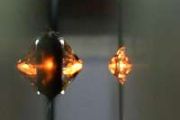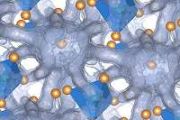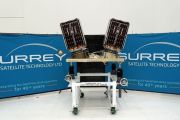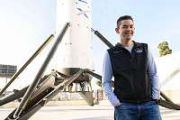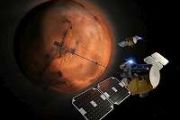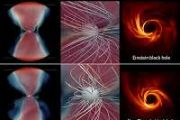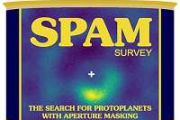
Copernical Team
'City killer' asteroid now has 3.1% chance of hitting Earth: NASA
 An asteroid that could level a city now has a 3.1-percent chance of striking Earth in 2032, according to NASA data released Tuesday - making it the most threatening space rock ever recorded by modern forecasting.
Despite the rising odds, experts say there is no need for alarm. The global astronomical community is closely monitoring the situation and the James Webb Space Telescope is set to
An asteroid that could level a city now has a 3.1-percent chance of striking Earth in 2032, according to NASA data released Tuesday - making it the most threatening space rock ever recorded by modern forecasting.
Despite the rising odds, experts say there is no need for alarm. The global astronomical community is closely monitoring the situation and the James Webb Space Telescope is set to Names of Chinese Lunar Rover and Spacesuits Announced
 China has officially revealed the names of its new spacesuits and manned rover, which will be used in upcoming lunar missions. The China Manned Space Agency announced Wednesday that astronauts walking on the moon's surface will wear spacesuits named Wangyu, meaning "Stargazing," while the crewed lunar rover has been designated as Tansuo, translating to "Exploration."
The agency elaborated
China has officially revealed the names of its new spacesuits and manned rover, which will be used in upcoming lunar missions. The China Manned Space Agency announced Wednesday that astronauts walking on the moon's surface will wear spacesuits named Wangyu, meaning "Stargazing," while the crewed lunar rover has been designated as Tansuo, translating to "Exploration."
The agency elaborated Karman Completes Expanded IPO with Full Over-Allotment Option Exercise
 Karman Holdings Inc., a leading provider of mission-critical systems for defense and space applications, has successfully closed its initial public offering (IPO), raising significant capital through an upsized offering that included a full exercise of the underwriters' over-allotment option.
The offering comprised 26,450,000 shares of common stock priced at $22.00 per share. Karman itself
Karman Holdings Inc., a leading provider of mission-critical systems for defense and space applications, has successfully closed its initial public offering (IPO), raising significant capital through an upsized offering that included a full exercise of the underwriters' over-allotment option.
The offering comprised 26,450,000 shares of common stock priced at $22.00 per share. Karman itself Star Catcher Secures AFWERX SBIR Phase 1 to Advance Space Power Beaming
 Star Catcher Industries, Inc. (Star Catcher), a pioneer in space-to-space power beaming, has been awarded a Small Business Innovation Research (SBIR) Phase 1 contract by AFWERX. This initiative aims to refine Star Catcher's technology for enhancing power capabilities of spacecraft in Low Earth Orbit (LEO).
The U.S. Department of the Air Force has an increasing demand for enhanced satellite
Star Catcher Industries, Inc. (Star Catcher), a pioneer in space-to-space power beaming, has been awarded a Small Business Innovation Research (SBIR) Phase 1 contract by AFWERX. This initiative aims to refine Star Catcher's technology for enhancing power capabilities of spacecraft in Low Earth Orbit (LEO).
The U.S. Department of the Air Force has an increasing demand for enhanced satellite York Space Systems Expands National Security Capabilities with Commercial Services Program
 York Space Systems (York), a leading aerospace company based in Denver, has launched a new commercial services program aimed at bolstering national security capabilities for the U.S. Government. This initiative provides essential space-based security solutions on a commercial basis, offering an agile and cost-effective approach to operational mission needs.
Building upon its proven satelli
York Space Systems (York), a leading aerospace company based in Denver, has launched a new commercial services program aimed at bolstering national security capabilities for the U.S. Government. This initiative provides essential space-based security solutions on a commercial basis, offering an agile and cost-effective approach to operational mission needs.
Building upon its proven satelli Does the universe behave the same way everywhere?
 "The cosmological principle is like an ultimate kind of statement of humility," says James Adam, an astrophysicist at the University of the Western Cape in Cape Town, South Africa, and lead author of a new study. The Cosmological Principle posits that no specific location in the Universe is unique or central, and that on the largest scales, the cosmos exhibits uniformity in all directions. This
"The cosmological principle is like an ultimate kind of statement of humility," says James Adam, an astrophysicist at the University of the Western Cape in Cape Town, South Africa, and lead author of a new study. The Cosmological Principle posits that no specific location in the Universe is unique or central, and that on the largest scales, the cosmos exhibits uniformity in all directions. This ESA advances HydRON project for next-generation space communications
 The European Space Agency (ESA) has taken a significant step in advancing space-based optical communications by signing a contract with Thales Alenia Space to develop Element #2 of the High-throughput Digital and Optical Network (HydRON). This initiative aims to deploy an advanced laser satellite system that will revolutionize data transmission across space. The newly planned satellite collector
The European Space Agency (ESA) has taken a significant step in advancing space-based optical communications by signing a contract with Thales Alenia Space to develop Element #2 of the High-throughput Digital and Optical Network (HydRON). This initiative aims to deploy an advanced laser satellite system that will revolutionize data transmission across space. The newly planned satellite collector Brown astronomers develop innovative method to filter interference in radio telescopes
 Astronomers analyzing data from the Murchison Widefield Array, a radio telescope in Western Australia, encountered an unexpected anomaly. Instead of deep-space radio signals from over 13 billion years ago, they detected a terrestrial television broadcast-despite the telescope's location in a designated radio quiet zone designed to minimize signal interference.
The surprising find led Brown
Astronomers analyzing data from the Murchison Widefield Array, a radio telescope in Western Australia, encountered an unexpected anomaly. Instead of deep-space radio signals from over 13 billion years ago, they detected a terrestrial television broadcast-despite the telescope's location in a designated radio quiet zone designed to minimize signal interference.
The surprising find led Brown University of Barcelona team theorizes singularity-free black holes through gravitational effects
 Traditional models of black holes, as predicted by Einstein's General Relativity, feature singularities-regions where physical laws cease to function. Understanding how these singularities might be resolved within the framework of quantum gravity remains a key challenge in theoretical physics. Researchers from the Institute of Cosmos Sciences of the University of Barcelona (ICCUB) have now provi
Traditional models of black holes, as predicted by Einstein's General Relativity, feature singularities-regions where physical laws cease to function. Understanding how these singularities might be resolved within the framework of quantum gravity remains a key challenge in theoretical physics. Researchers from the Institute of Cosmos Sciences of the University of Barcelona (ICCUB) have now provi Tidal energy data aids SwRI scientists in unraveling Titan's composition and orbital shifts
 Researchers at Southwest Research Institute (SwRI) are examining Saturn's largest moon, Titan, to determine its tidal dissipation rate-the energy lost as it interacts with Saturn's immense gravitational field. Insights into this process provide valuable clues about Titan's internal composition and its orbital development over time.
"When most people think of tides, they picture ocean movem
Researchers at Southwest Research Institute (SwRI) are examining Saturn's largest moon, Titan, to determine its tidal dissipation rate-the energy lost as it interacts with Saturn's immense gravitational field. Insights into this process provide valuable clues about Titan's internal composition and its orbital development over time.
"When most people think of tides, they picture ocean movem 



